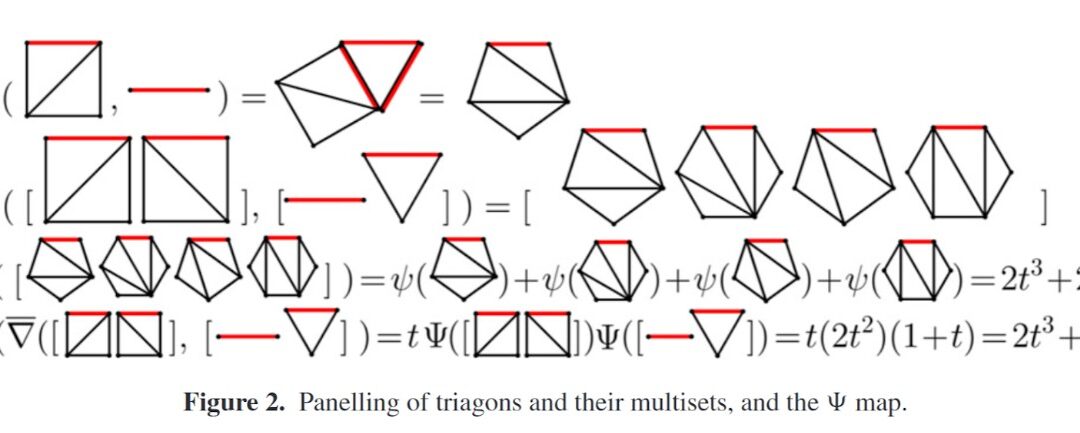Just like you and me, Dean Rubine admits that he sometimes wastes time online.
“When I’m not doing my real job, I like to watch math on YouTube,” he said.
OK, maybe he’s not just like you and me. And as we’ll see, it’s not always a waste of time.
Rubine is a computer and technology guy, a former Carnegie-Mellon professor, who lives in Lee. He’s not a mathematician but is intrigued by the field – he co-coaches the Mathcounts team at Oyster River Middle School – and likes learning about higher math, the stuff that builds abstraction atop abstraction to create what Galileo called “the language by which God has written the universe.”
In his online wanderings, Rubine stumbled across the channel of Australian mathematician N.J. Wildberger. Intrigued, he subscribed to the feed. “He said, join my YouTube and I will teach you how to do research, and for the first problem, we will solve the general polynomial. I thought he was joking,” Rubine said.
But he wasn’t. Forty-one videos later, they had a way to derive the polynomial formula, the general formula that solves polynomial equations of any degree – one of the great problems of mathematics – using something called Catalan numbers. Rubine wrote it up as a traditional research paper and, after edits from Wildberger, it was published in the May issue of the American Mathematical Monthly, the mostly widely read mathematics journal in the world, under the title ”A Hyper-Catalan Series Solution to Polynomial Equations, and the Geode.”
Response from within the mathematical community has been good – the online version had more than 84,000 views when I checked. Even if it’s not going to lead to a Fields Medal, there’s a real satisfaction in translating a small part of God’s language.
So what exactly did they show?
Polynomials are algebraic equations. You can follow a big chunk of the history of mathematics by seeing what level of polynomials we could solve at any given time. First solved were those with simple variables, then squared variables, then cubed, then variables raised to the fourth power. And finally, as part of modern math’s discovery of its own limits, absolute proof that no solution was possible for polynomials of higher values, a.k.a. the “general polynomial.”
Wildberger and Rubine have not found an absolute solution of the general polynomial – that would be earth-shaking – but introduced a different way of approximating them. “Computers already know how to find approximate numerical solutions using Newton’s method, and our paper suggests an improvement which might make that computation more efficient,” Rubine said. (ADDENDUM: Rubine reached out and said yes, they’ve proved an absolute solution through infinite series.)
The workhorse of the paper are Catalan numbers, which were discovered or invented (take your pick) as a way to count how many triangles could fit into any convex polygon. That sounds intriguing but unimportant, like a question taken from a Mensa application, but Catalan numbers are the underpinnings of combinatorics, a field that has blossomed in the last half-century to be both deeply abstract and incredibly useful in fields from manufacturing to computer algorithms, despite the fact that it just involves counting things.
Rubine told me he has since found that Newton also discovered their method, although it never gained widespread use.
“To me the real value is that our paper shows that the solution of a polynomial is not just a number which, when plugged in, gives a bunch of terms that add to zero, or approximately zero. The solution is really an intricate, infinite puzzle, with the fascinating property that when we combine all the pieces with all the other pieces in every possible way, we get the original set of pieces back, all except one.”
And then there’s the Geode, which they say is an entirely new mathematical entity. I can’t say I completely understand it. (Translation: I definitely don’t understand it.)
The paper calls it “the mysterious Geode array which algebraically encodes the hyper-Catalan numbers” and includes “several compelling conjectures about this remarkable new algebraic object.”
The real value of most mathematical research papers isn’t what they prove, it’s the methods by which the proof is reached. If other mathematicians can use those methods to make new findings, then it’s important.
Is the Geode an important finding? Will it be useful and insightful for others in the field? Will Wildberger and Rubine’s paper become part of the history of important math discoveries linked to New Hampshire, alongside Yitang Zhang’s work on consecutive primes and Thomas Kurtz’ work at Dartmouth?
Maybe. But even if not, it’s a reminder that pursuing knowledge for its own sake is a great way to spend your time. Even if you have to go to YouTube to do it.


 Return to the Concord Monitor
Return to the Concord Monitor
Thank you very much for the profile, Mr. Brooks. I really appreciate you helping to spread the word on this groundbreaking work.
Please allow me to use this space to make some minor corrections that almost certainly resulted from me not being sufficiently clear with you.
* “Intrigued, he got in touch.” Actually, I didn’t really contact NJW, just watched his ad, and then joined. I still pay $5 a month for access!
* “Wildberger and Rubine have not found an absolute solution of the general polynomial – that would be earth-shaking…” No, we really found a solution to the general polynomial. It is earth-shaking. Our solution is an infinite series, so if you take a few terms of it you can generate approximations.
* I did indeed find that Newton essentially wrote 12 terms of our solution in 1677, though he didn’t have the general formula, a proof, or the combinatorial significance of the numbers appearing.
* You misspelled my name at the end there.
Thanks again,
– Dean Rubine